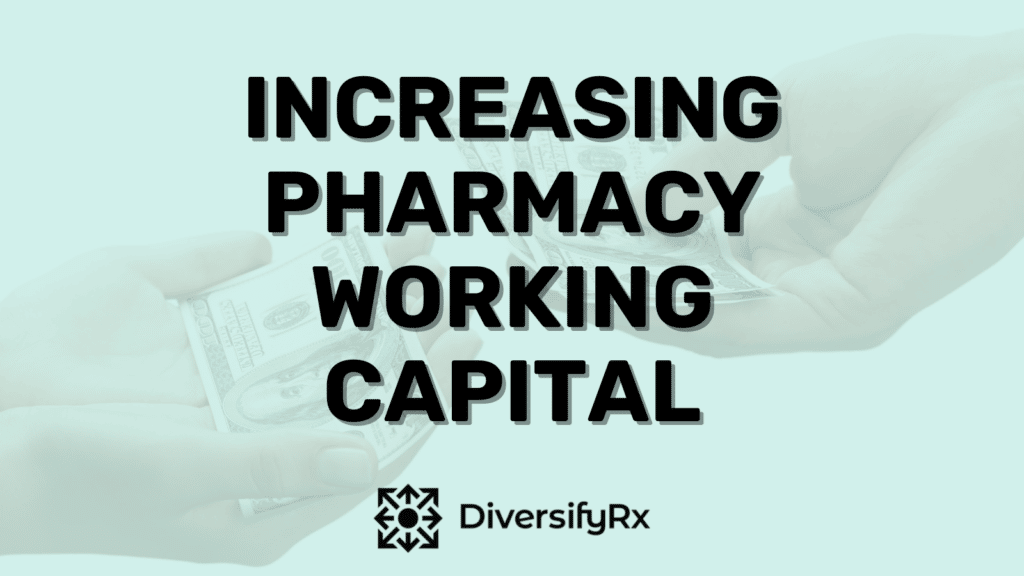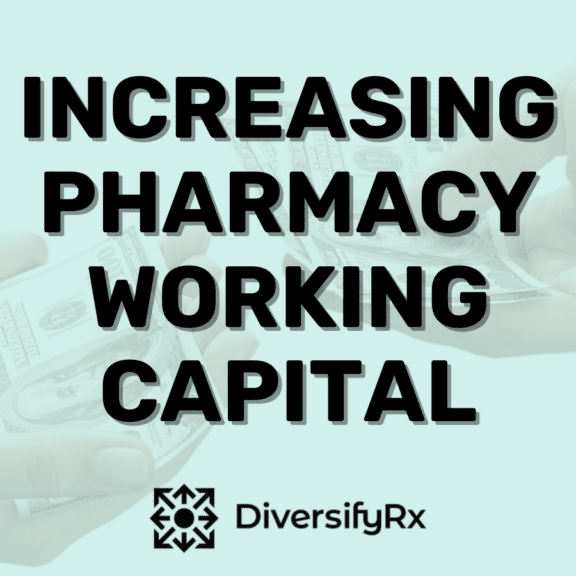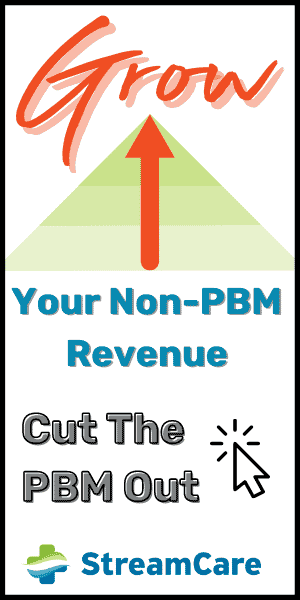Many pharmacy owners will need a source of working capital at some point in their ownership journey.
Pharmacy Cash Flow Is Tight
Recently we put up a poll on our LinkedIn and Facebook pages, asking pharmacy owners if they were interested in learning about financing working capital. The overwhelming response was YES, as many pharmacy owners are dealing with tight cash flow, increased costs, etc.
I love to talk about cash flow, finances, numbers, and all those nitty-gritty things that most people hate to discuss. I know, I am weird. I recently spoke with a financial friend Carlos. We discussed the financial barriers that are currently plaguing pharmacies and some possible solutions to help ease cash flow.
Carlos shared solutions from a financial standpoint that you can use to help increase your working capital to keep your pharmacy running and take care of those advantages and opportunities.
A Little About Carlos
Carlos is the CEO of Capital Solutions Bancorp. They have been around for over 20 years and provide working capital for small and medium-sized companies. While other banks typically offer a full suite of financing options, Carlos specializes in working capital. Being specialized helps him be an amazing resource for pharmacy owners to learn how to better manage the cash flow through their pharmacy business.
Below is a summary of our conversation that I hope you can glean useful information from to improve your pharmacy’s financial situation.
What is Working Capital?
If you are a financial nerd like me, you probably know what working capital is. Most pharmacy owners, managers, and staff pharmacists have yet to learn what working capital is, though you probably know it is crucial.
Working capital has some very sophisticated accounting definitions that financial people use. It doesn’t need to be complicated, though. Let me give you my basic definition of working capital.
Working capital is the amount of money your pharmacy needs to pay bills before it can collect its income. It’s as simple as that.
You need money to make money, is undoubtedly a true statement. Bills are often due before you receive your money. This reason is why having cash available is so critical to the success of your pharmacy. Pharmacy owners’ #1 headache isn’t profitability; it is a lack of cash and, more specifically, working capital.
It’s a timing gap between payables and receivables.
The best way to visualize this is that if payables (bills) were simultaneous with receivables (revenue), there would be no need for working capital.
When I talk to pharmacies, I often tell them that working capital, your cash flow, is the money you need to pay your wholesaler before you get paid from insurance.
Working capital is an extra cushion that you need in your bank account.
Why Is Your Working Capital Low?
There are many reasons why a pharmacy might be low on working capital.
I almost grew myself out of business several times in my first pharmacy. It seems a bit illogical. You are growing rapidly, and yet the cash is disappearing. This timing gap is because you often have to pay your bills before getting paid by insurance. When I had extremely rapid growth periods, my cash flow suffered. Trust me; it caused many sleepless nights and tons of stress.
Growing is good, and yet low working capital is bad.
Another reason you might have low working capital is you need more profits. Even if you’re collecting all your money, your profits are so low that you don’t have anything left over.
Consequences of Not Having Enough Working Capital
In addition to immense stress, there are other side effects of not having enough working capital for your pharmacy. Here are a few:
- You stop pursuing growth strategies
- You can’t start a new revenue-generating service
- You can’t take advantage of a good buying opportunity
- You don’t have enough cash to fund a marketing campaign
- You can’t pay your bills
- You pay your bills late, incurring expensive late fees
- You can’t make necessary hires or retention decisions
- Many, many more…
Essentially, when your working capital is low, your pharmacy is stuck. It can’t move forward, it can’t evolve, and you, as the pharmacy owner, experience intense negativity.
It just makes for a pretty miserable life as a pharmacy owner.
Predicting Low Working Capital
An excellent KPI to track how you are doing with your cash flow is the Number of Days of Cash On Hand.
The days of cash on hand number lets you know how many days you could operate your pharmacy based on the amount of cash you have now. The more days of money you have in the bank indicates a stronger pharmacy with good cash flow.
There are a couple of ways you can calculate this number. Some financial people will tell you to only include your operational expenses in this calculation. I’m afraid I have to disagree with this. That advice typically comes from someone not in the pharmacy industry. In our world, our inventory cost is a massive drain on our cash. Include all your expenses and inventory purchases in the calculation to accurately reflect your pharmacy’s health.
Calculate:
- Add up the available cash from all your accounts.
- Total all your expenses from the previous month and then divide them by the number of days in the month to generate a daily average for your pharmacy’s expenses and inventory purchases.
- Take the total in cash and divide it by the daily expense average. This answer will give you your days of cash on hand.
Goal: 15 days or more indicate a strong pharmacy.
How Can A Pharmacy Get More Working Capital?
Carlos helped me iterate our pharmacy owners’ options to acquire more working capital for their pharmacies.
Before you go for working capital financing options, consider operational changes first.
- Decrease unnecessary expenses
- Clean up and return your excess inventory
- Renegotiate payment due dates with your large vendors
- Check out our other cash flow recommendations HERE
Financing Options for Working Capital
The first option, and the one I recommend, is getting a line of credit from your local bank.
The challenge with this option is that banks are rearview mirror lenders. They want to see the last two years of financials and other past performance documents. They’re looking at your past, which usually has nothing to do with what you’re doing next year, and your needs for working capital going forward.
Banks love lending money to people who don’t need it. So take this advice and apply for a line of credit BEFORE you actually need it. Once your working capital has been depleted, it can be harder to be approved.
A second option is what Carlos and his company specialize in—financing your working capital through your receivables (money coming into your pharmacy).
Capital Solutions takes all the receivables you have, and they advance you that money so that you can use that money now. It gives you access to your future money today. Their solution is a PRN method.
If you don’t need it, don’t use it. There is no long-term contract or minimum usage. Capital Solution’s safety net is there in case you need it. And unfortunately, when you need working capital, you need it. In addition to getting the cash you need, they also help you understand how to manage future cash better. So you get the help you need and become a better pharmacy owner!
If you want to see if Carlos can help your pharmacy, his cell phone number is 239-822-9906.















